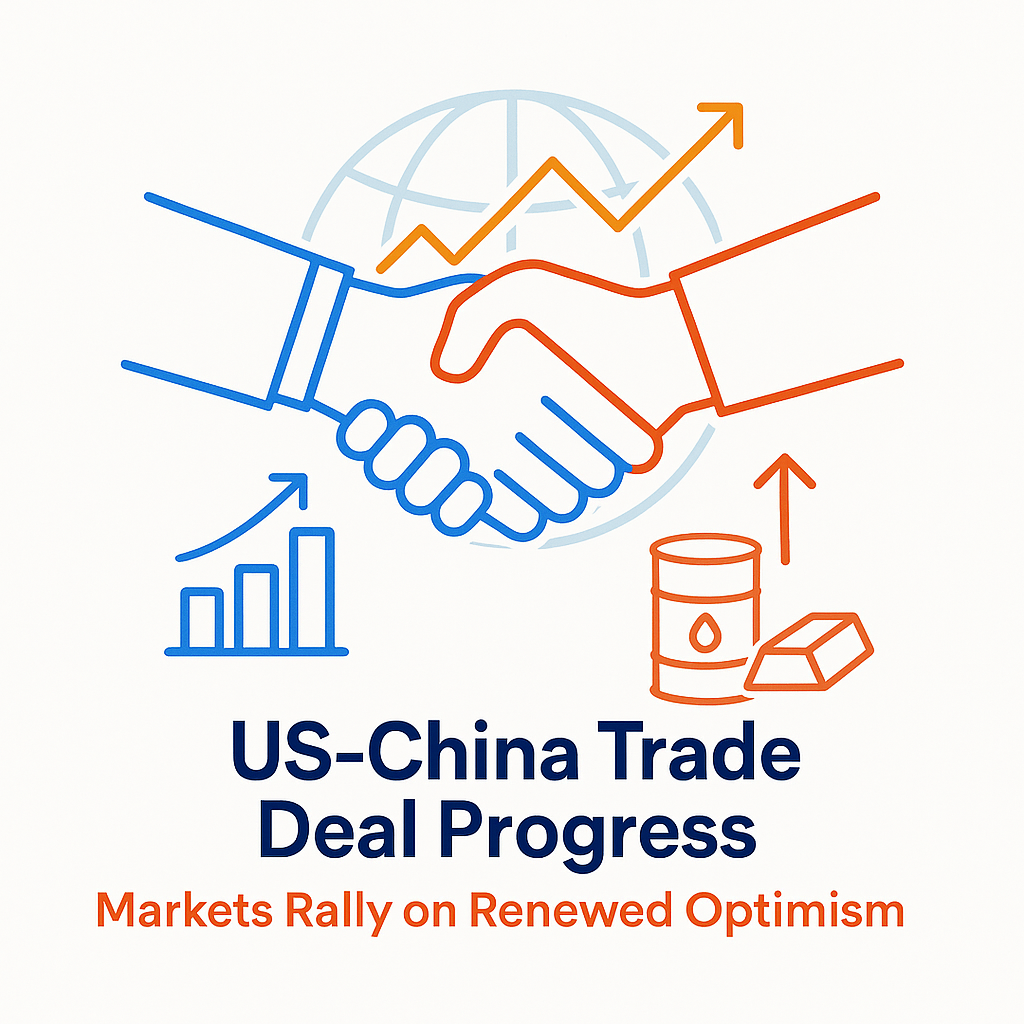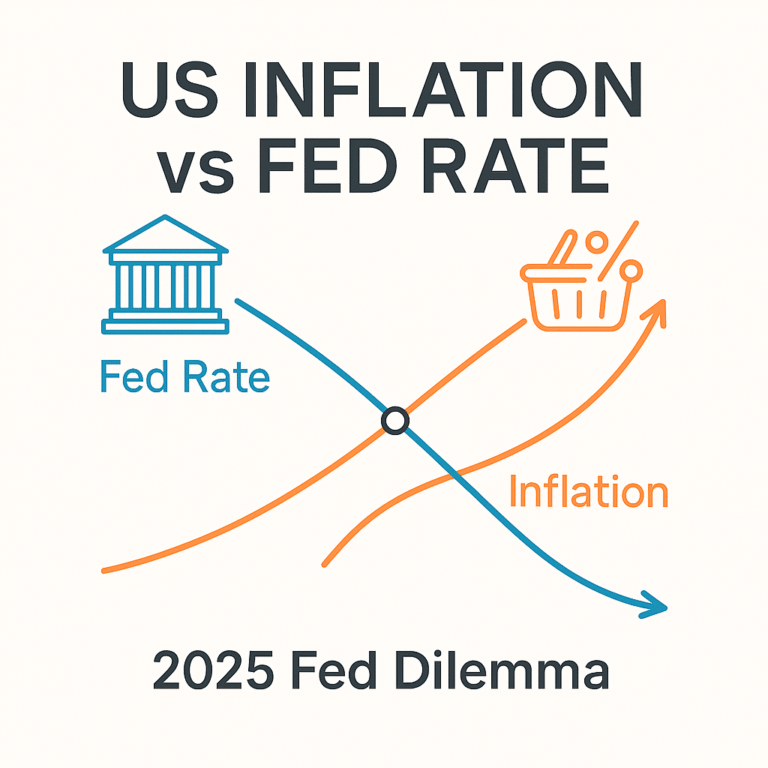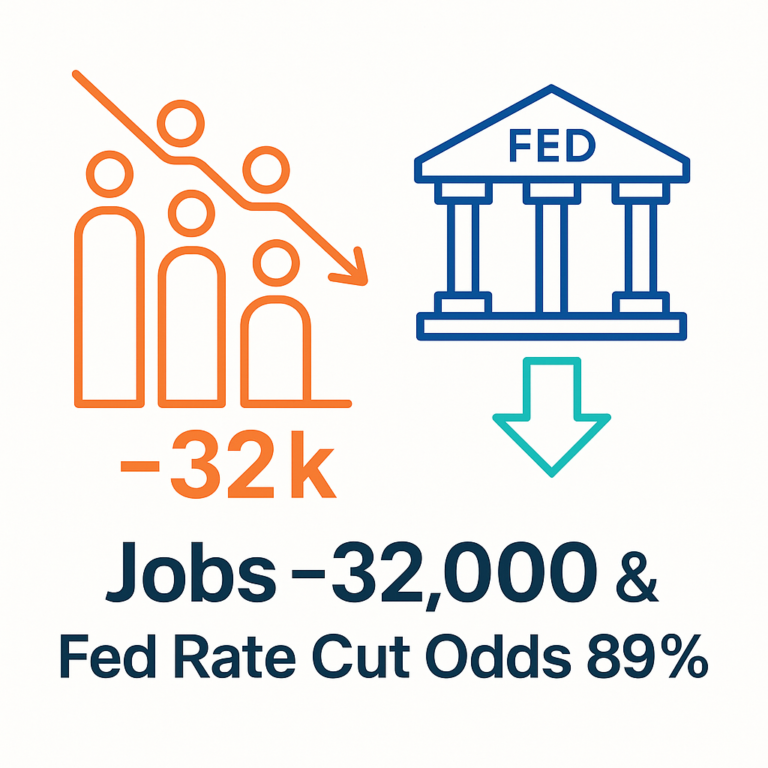How the US-China Trade Deal Progress Is Moving Stocks, Commodities, and Currencies
Markets rallied as the US and China made tangible progress in trade talks. Stocks, commodities, and currencies all responded, signaling renewed optimism for global growth.
Key Takeaways
✔ The US and China are reportedly close to finalizing a broad trade deal, lifting global market sentiment.
✔ Stocks, commodities, and risk-sensitive currencies rallied, while safe-haven assets like gold slipped.
✔ China-exposed companies and resource producers saw short-term gains.
✔ Unresolved political and supply-chain issues still pose medium-term risks for investors.
Why the Latest US-China Trade Negotiation Progress Matters
On October 26, Bloomberg reported that the US and China were “nearing the final stage of trade negotiations.”
That headline triggered an immediate market reaction — US stock futures jumped, and copper and oil prices climbed sharply.
This development goes far beyond diplomacy.
Progress in the US-China trade deal has direct implications for global supply chains, inflation trends, and corporate earnings.
As both economies face slower growth, investors see this as a key signal that trade stability — and global demand — may finally be returning.
From Tariffs to Talks: A Shift Toward Practical Compromise
The trade tensions between Washington and Beijing date back to 2018, when the Trump administration imposed steep tariffs on Chinese goods.
Over the years, disputes over semiconductors, rare earths, and technology access deepened the divide.
Now, in late 2025, both sides appear to have pragmatic reasons to compromise.
With global growth cooling and inflation easing, the two governments resumed formal talks.
At the fifth negotiation round in Kuala Lumpur, they reportedly made progress on agriculture, metals, and semiconductor supply chains.
China resumed purchases of US soybeans, while Washington hinted at possible tariff relief on critical minerals.
|
Date |
Key Event |
Market Reaction |
|---|---|---|
|
Oct 20 2025 |
Kuala Lumpur round announced |
Rising optimism |
|
Oct 26 2025 |
Report: deal near completion |
Global stocks rebound |
|
Oct 27 2025 |
Copper nears record high |
Commodity rally continues |
This marks the most meaningful thaw in trade relations since the tariff war began seven years ago.
Market Reaction: Stocks, Commodities, and Currencies Move Together
Stock Market
The US stock market reacted immediately to signs of progress.
S&P 500 futures rose 1.2%, Nasdaq 100 gained 1.5%, and Asian indexes followed — the Nikkei 225 and KOSPI both climbed nearly 2%.
Investors interpreted the news as a risk-on signal, easing fears of a global slowdown. (Bloomberg, Oct 26 2025)
Commodities
- Copper broke above $10,000 per ton, approaching a new record as manufacturing optimism returned.
- Brent crude rose more than 1.5%, supported by both trade optimism and ongoing supply risks. (Reuters, Oct 22 2025)
- Gold, meanwhile, slipped about 1% as safe-haven demand faded.
Currency and Bond Markets
Commodity-linked currencies like the Australian and New Zealand dollars strengthened against the US dollar.
US Treasury yields ticked higher as traders priced in less demand for safety assets.
|
Asset |
Before Progress |
After Progress |
Driver |
|---|---|---|---|
|
S&P 500 Futures |
Flat |
+1.2% |
Risk appetite returns |
|
Copper |
$9,700 / ton |
$10,000 / ton |
Manufacturing optimism |
|
Brent Oil |
$84 / bbl |
$85.5 / bbl |
Demand recovery |
|
Gold |
$2,380 / oz |
$2,355 / oz |
Lower haven demand |
|
AUD/USD |
0.66 |
0.68 |
Trade optimism |
What Experts Are Saying
According to Bloomberg Markets, “This is not just a tariff story — it’s a structural signal that global demand could be turning a corner.”
A Discovery Alert report added that “meaningful progress in metals and agriculture may mark the start of a new commodity cycle.”
Economists broadly agree that a credible US-China trade framework could revive industrial activity, stabilize prices, and lift investor confidence.
In other words, the progress may represent the first tangible sign of global economic re-acceleration heading into 2026.
Investor Takeaways: Which Sectors Benefit Most
Commodity and Energy Producers
Improved trade relations tend to boost demand for industrial inputs.
Mining giants such as BHP and Rio Tinto —and broad commodity ETFs—stand to benefit from renewed infrastructure and export activity.
US Companies with China Exposure
Firms like Apple, Tesla, and Starbucks, which rely heavily on Chinese sales, could see earnings relief if tariffs ease.
The consumer, automotive, and tech hardware sectors appear best positioned for near-term gains.
Semiconductor Supply-Chain Firms
Semiconductor production remains central to both nations’ industrial strategies.
Companies like TSMC, Samsung, and NVIDIA could gain from clearer trade rules and stabilized component flows.
What’s Next: The Trump-Xi Summit and Key Milestones
Bloomberg reports that a Trump-Xi leadership summit is scheduled for early November.
If a formal framework emerges, it could trigger another wave of optimism and drive global trade volumes higher in 2026.
However, partial or delayed agreements might spark market pullbacks.
US election politics and China’s domestic stimulus pace are likely to shape how durable this optimism becomes.
Key Risks: When Optimism Runs Ahead of Reality
Markets have already priced in much of the trade optimism.
If the final agreement disappoints, investors could face a sharp short-term correction.
Another risk: a renewed commodity rally could re-ignite inflation pressures, forcing the Federal Reserve to delay rate cuts.
The balance between growth hopes and policy caution defines this transitional phase in global markets.
The progress in US-China trade talks has sparked a rare moment of synchronized optimism across asset classes.
Stocks are rising, commodities are rebounding, and global risk appetite is improving.
Yet the deal remains unfinished — and structural tensions over technology and supply chains persist.
Investors should treat this as a potential turning point, not a full-fledged recovery.
A diversified approach — gradually adding cyclical exposure while maintaining defensive assets — remains the most prudent strategy as the world waits for the next headline.
References
- Bloomberg – US Stock Futures Jump on China Trade Deal Progress
- Bloomberg – Copper Set to Test Record High on US-China Trade Talks Progress
- Reuters – Oil Maintains Gains amid Supply Risks and Trade Talk Optimism
- Discovery Alert – US-China Trade Negotiations 2025: Diplomatic Efforts and Implications
- Seeking Alpha – U.S. and China Signal Progress as Soybean Purchases Resume







